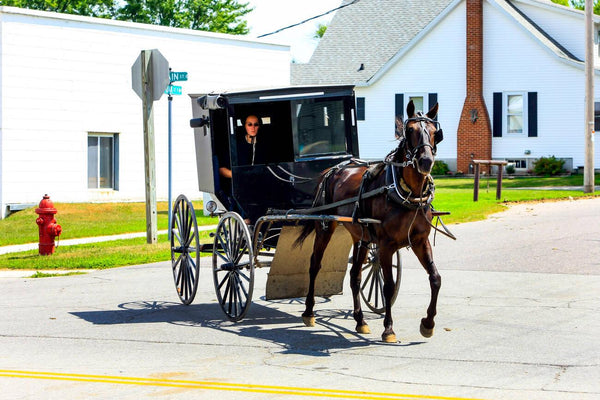Despite being surrounded by modern-day conveniences and progressive thought, Amish folk culture is flourishing.
The Amish have managed to build and maintain a strong society based on old-time values and traditions.
And what’s more, the Amish are one of the fastest-growing populations in the world. That means there’s no shortage of people around to keep their traditional folk culture alive.
So what’s their secret? How do they do it?
We’re about to dive right into Amish culture, and Amish folk culture and reveal how it has managed to survive all these years.
We’ll specifically discuss Amish material culture and Old Order Amish beliefs. We’ll also reveal the truth behind Amish blue doors and barn signs.
But first, let’s take a closer look at Amish culture.
What this article covers:
Amish Culture

Amish culture is rich with traditions and historical customs.
While they originated in Europe, they now exclusively live in the US and Canada.
They’re known for their uncomplicated existence and their unwavering dedication to living simply according to God’s will. The Amish are immensely family-orientated and make minimal use of technology, making them some of the most self-sufficient people in the modern world.
The Amish are happy as they are and avoid change for the sake of change wherever it’s humanly possible. This, combined with their limited connection with the outside world, has made it possible for them to uphold their traditional folk culture.
It’s common for Amish people to live, work and enjoy recreational activities only within their communities. Many Amish enjoy craftsmanship, such as making traditional faceless Amish dolls, fruit harvest baskets, and bread storage boxes.
The Amish are a denomination of the Anabaptist church, and therefore they’re Christians. They broke away from the church in 1963 following a schism between a group of Swiss and Alsatian Mennonites.
Alongside their beliefs, the Amish place value on rural life, manual labor, and Gelassenheit (submission to God’s will).
Situated in the middle of progressive mainstream culture, the Amish have successfully preserved the core identity of their close-knit community.
Let’s explore some of the Amish folk culture and how it’s still relevant today.
Old Order Amish Beliefs
The Old Order Amish are who people think of when they hear the word Amish.
They’re considered the original Amish, from which numerous subgroups have formed over many years.
There are four core values of Amish folk culture. Let’s take a look at each of them in turn.
- Faith: the Amish are Christians, so there’s a notable emphasis on biblical teachings in their culture.
- Family: the Amish place a noticeable emphasis on family life. They typically have many children and therefore large, close families are a significant facet of Amish life.
- Community: their large families also make up a large community. The Amish, therefore, have a strong sense of community. They live, work and play within their community and try to limit connection with the outside world.
- Simplicity: from their plain clothes to their rejection of modern technology, the Amish are known for their simple way of life.

While these values are sadly slipping away in favor of popular culture in most of Western society, the Amish have maintained a deep connection with them.
This may be due to their limited connection with outsiders. Another interpretation is that the Amish are simply happy with what they have and who they are.
After all, if it isn’t broken, don’t fix it.
This minimal contact and lack of desire to change have allowed the community consistent over many generations and keep Amish folk culture relevant today.
Amish Material Culture
Each Amish community has a set of agreed-upon community rules, known as Ordnung.
The Ordnung outline what people should wear, which technologies are allowed, and what recreational activities are permissible.
Let’s take a closer look at some of the day-to-day rules for Amish people and how they connect to Amish folk culture.
Clothing
Outsiders often recognize the Amish by their plain clothing made from homemade fabrics.
Women wear long dresses, which are usually dark colors such as brown, black, burgundy, or blue. Some Amish subgroups have introduced brighter colors, but this isn’t very common.
Additionally, they sometimes wear an apron that covers the front of their dress.
Amish women don’t cut their hair and always keep it covered when they’re outside. It’s acceptable for them to wear their hair loose when they’re at home.

What about the Amish men?
They wear black suits, pants, and white-collar shirts. They choose to wear suspenders to hold up their trousers as belts are seen as too flashy.
Unmarried men must be clean-shaven. Once a man is married, he grows a beard.
These clothing rules intend to maintain a certain level of order and consistency in Amish life and Amish folk culture. Because they don’t espouse vanity, the Amish don’t encourage lavish styles or vibrant patterns.
Use of Technology
In contrast to the rest of the world, the Amish prefer basic living and don’t typically permit the use of technology.
Generally speaking, the use of electricity, television, cars, radios, and phones are forbidden.
Yet, in regards to technology use, there are many differences between various Amish groups.
The Swartentrauber Amish are considered the strictest group of Amish due to their restrictions on technology. For example, they aren’t allowed to ride in cars, except in emergencies.
In contrast, New Order Amish do allow some electricity, and some even have telephones at home.
The reason behind this resistance to technology is to avoid an unhealthy reliance on the conveniences of modern technology. This is one of the key factors in keeping folk culture booming. Without the distractions of technology, this culture can continue to thrive.
Transportation

Considering how carefully many Amish communities avoid technology, their chosen mode of transport is one which makes them stand out.
Their preferred transportation is a horse and carriage.
While there are different styles of carriages amongst various groups, it’s clear that the method itself is a simple, old-fashioned one.
It’s worth noting that the Amish do sometimes take rides in cars with non-Amish people, and some communities do allow car ownership.
Barn Signs
A lot of people associate amish barn signs, also known as hex signs, with the Amish. However, the Amish actually don’t use hex signs.
Hex Signs are original Pennsylvanian Dutch folk art. They’re part of the Fancy Tradition in Pennsylvanian Dutch County.
They typically include pictures of stars, compass roses, birds, and the tree of life. It’s also common to see geometric patterns of quilts on the hex signs.
In the 1950s, these barn signs became popular items aimed at tourists.
During the 20th century, people would place them at the entrances to their barns or use them as decorations in their homes.
It’s particularly common to see them in Berks County, Lancaster County, and Lehigh County. However, you won’t find them in Amish communities. Instead, they’ll be in Pennsylvanian Dutch barns.
Amish Blue Doors

While there’s a lot of speculation and rumors surrounding the meaning of Amish door colors, the explanation may come as a bit of a letdown.
Many Amish people paint their front door a light blue color which has led to much speculation about the origins of this custom.
Some believe that it means the family has a daughter who is eligible to be wed.
However, the truth is there’s no known tradition or meaning behind the Amish blue door.
When asked, Amish people often state that it’s simply tradition.
There may have once been an attached meaning to the blue door, however, today that’s no longer the case.
Conclusion
The Amish have a long-standing history and many traditions which have lasted for centuries.
It’s quite an achievement that they’ve maintained the values and customs of the Amish community so well, despite the evergrowing advancements of modern technology.
It’s clear the Amish folk culture isn’t going away any time soon. You too can keep the Amish folk culture alive with these Amish kitchen storage baskets for shelves and wicker file baskets.
Did You Find Our Blog Helpful? Then Consider Checking:
- Amish History
- What Language Does the Amish Speak
- What Are Amish People
- Types of Amish
- Amish Traditions
- Are the Amish German
- Amish Names
- Amish Last Names
- Amish Town Names
- Amish Religion
- Do Amish Believe in Jesus
- What Bible Do the Amish Use
- What Day Do the Amish Go to Church
- Amish Sunday Rules
- Are Amish Polygamists


